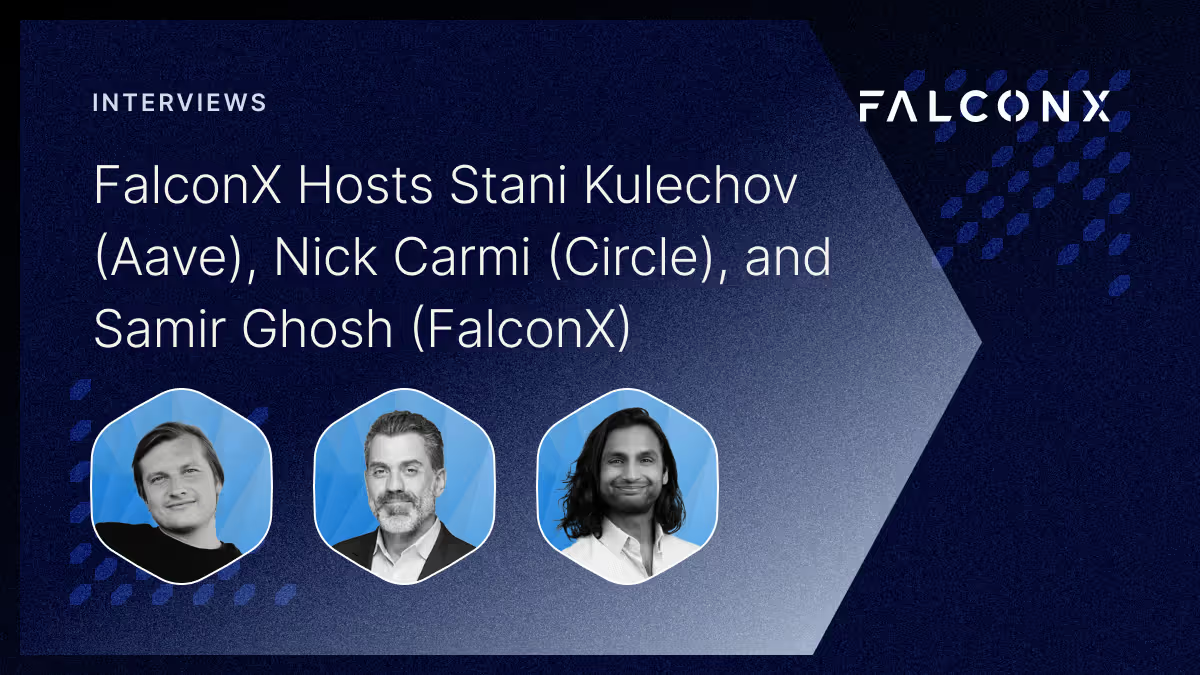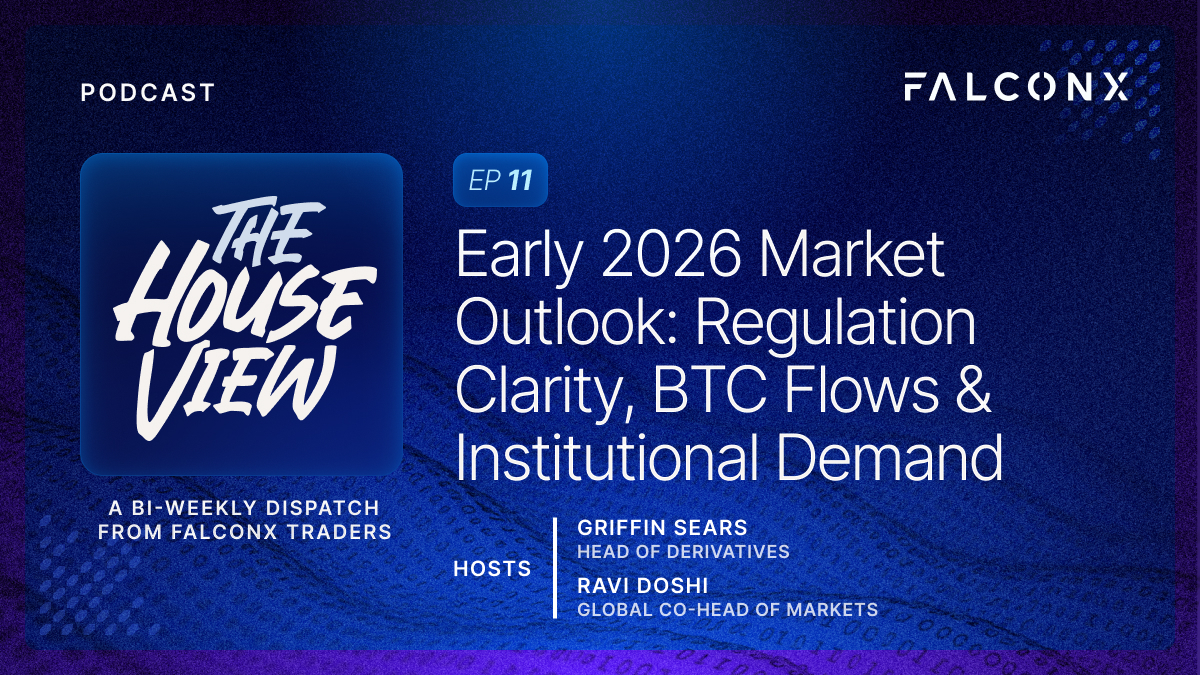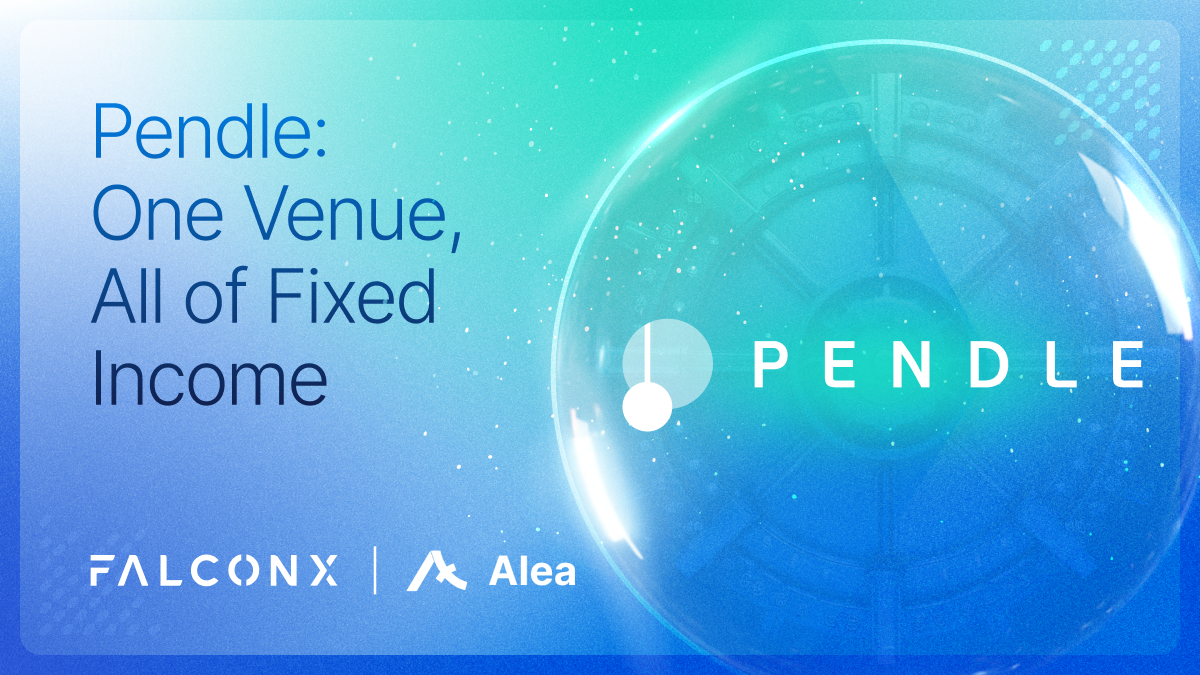FalconX Hosts Stani Kulechov (Aave), Nick Carmi (Circle), and Samir Ghosh (FalconX)

Creating a Safer Operating Environment:
Combining TradFi Market Structure and Blockchain Tech
Baris Cetinok, Chief Product Officer
The last 18-months have been pivotal for the crypto industry, as significant events challenged our assumptions of how the industry should look, and what rails, if any, can be adopted from traditional finance to better protect and serve its users. FalconX’s second episode of our webinar series, Creating a Safer Operating Environment: Combining TradFi Market Structure and Blockchain Tech, aimed to answer this question through open dialogue with industry leaders. We invited Nick Carmi, Head of Institutional Capital Markets at Circle, Stani Kulechov, CEO and founder of Aave, and FalconX’s Samir Ghosh, our Head of Product, to discuss how we can learn from recent events, identify what’s currently missing, and how to move forward and continue building trust in the market.
Our conversation centered around a hypothesis: the goal for digital assets shouldn't necessarily be to reinvent the wheel; TradFi market structure has evolved and been refined over the course of decades, and through continued iteration, have (arguably) built a robust model. Rather than reconstructing, it’s the coupling of TradFi market structure and blockchain tech that can establish a trusted crypto economy. While reinventing the wheel may be unnecessary, innovation is welcome as we look to bring TradFi rails on chain. Through leveraging DeFi, blockchain technology can enhance TradFi market structure and enable more transparent, efficient, unified and corruption resistant markets. Realizing this and creating a harmonious ecosystem requires meeting the needs and gaining the trust of institutional investors, a user base which up until recently has rejected the technology's adoption.
TradFi market structure, while imperfect, has demonstrated strengths over the years. Custodians, third-party and tri-party solutions have been built to keep assets safe and the threat of bankruptcy remote. Recent events in crypto have demonstrated that diverting away from this proven structure has hefty consequences.
We addressed these recent events in the industry while considering TradFi market structure to create a safer blockchain operating environment. In our webinar, we explored the existing custody infrastructure, adopting TradFi market structure and a view into what the industry’s future may hold.
Custody, security and market structure:
The concept of custody arose from The Investment Company Act of 1940—a law passed to create a more stable financial market regulatory framework following the Stock Market Crash of 1929. A series of scandals leading to the crash proved companies couldn't be trusted to act in the best interest of investors and there needed to be a role in markets explicitly tied to the safekeeping of assets.
In the decades since, we have learned that strong markets need a separation between roles and responsibilities. As infrastructure providers, custodians shouldn't be in the business of taking risks but of providing technology to facilitate risk-takers to enter and exit risk on/off positions efficiently. If they can do their job effectively, we will have safer and sounder markets for institutions to access asset classes.
We're beginning to see these roles meld regarding digital asset classes. Investors are asked to pre-fund their assets to trade on almost any digital asset exchange, something TradFi has moved away from. History tells us that holding assets without being tasked explicitly with safekeeping them creates a strong incentive to generate a return by lending or trading them. TradFi markets have shown us that this isn't necessarily in the client's best interest.
The introduction of tri-party systems into crypto was a step to manage risks in a way that mirrors TradFi. In this system, two parties are conducting financial transactions while a third party, a custodian or collateral management firm, manages the transaction’s assets.
The promise of DeFi:
Decentralized Finance (DeFi) is a relatively new concept, and despite a few tumultuous years, it has grown exponentially. Even in the 2022 market turmoil, DeFi maintained strength in total value locked (TVL), bolstered by the success of its early applications, such as AMMs and money markets. One such area of growth is the rapidly increasing popularity of liquid staking derivatives (LSDs), which is driving cash into DeFi and causing a rebound after a tough year.
Building DeFi applications for institutional investors has been difficult; it was a new category and a new place to invest. Transparency is key with institutional investors. The first on-chain trade with JP Morgan was a tokenized cash deposit using verifiable credentials. While the blockchain has tracing capacities, this addition gave the trade a specific identity. After this initial trade, the industry took hold of the new technology.
Already demonstrating the tremendous potential for individual investors, the promise of institutional-grade DeFi solutions is exciting to consider. Using blockchain technology, DeFi has created a decentralized, peer-to-peer system that makes financial services available to anyone.
It's easy to see how this benefits people in underserved communities or remote locations, but the potential for institutional investing is enormous.
When the topic of DeFi arises, people's minds often go to yield farming, lending and other complex use cases that sit layers above the core. But every day, FalconX and other global institutions settle billions of dollars in transactions seamlessly and securely on-chain across the globe. If we could re-engineer the effective parameters of the TradFi structure to make it more transparent and efficient, the result would be DeFi.
Moving forward:
Part of cryptocurrency's appeal is the notion of discretion and security, and many early adopters are eager to forgo building a regulated market structure. But the pitfalls of forgoing regulation altogether are many, and bringing in the next billion users will require us to consider increasing transparency, and strengthening market structure to encourage secularism to battle corruption in crypto and DeFi.
That includes considering the role of custodians in the evolution of our market structure. That, combined with essential Know-Your-Customer and anti-money laundering (“KYC/AML”) regulations, are the next compliance layer currently missing in blockchain and crypto. But for DeFi to take off at the institutional level, every trader must provide identity verification.
It's an exciting moment in crypto, where financial institutions recognize the opportunity in front of us. We're building an industry that leverages the best of TradFi market structure and the transparency of blockchain to create a DeFi ecosystem that works for institutions.
If you'd like to dive deeper into this discussion, listen to our recent webinar: Creating a Safer Operating Environment: Combining TradFi Market Structure and Blockchain Tech.
This memo is for informational purposes only and does not constitute investment, legal, tax, or financial advice, nor a recommendation to buy, sell, or hold any digital asset. Forward-looking statements reflect current expectations and involve substantial uncertainty; actual results may differ materially. Data sourced from third-party providers is believed reliable but has not been independently verified. Authors, Alea Research, FalconX, and their respective affiliated parties may hold positions in assets discussed, which may change without notice. Digital assets involve substantial risks including smart contract vulnerabilities, regulatory uncertainty, liquidity constraints, and total loss of principal. Recipients are responsible for their own due diligence and compliance with applicable laws. Alea Research and FalconX are not affiliated with, endorsed by, or sponsored by, each other.
This material is only intended for sophisticated or institutional investors. Neither FalconX Limited, FalconX Bravo, Inc., FalconX Delta, Inc., FalconX Foxtrot Pte Ltd., FalconX Golf Pte Ltd., Solios, Inc., Falcon Labs, Ltd., KestrelX, Ltd. nor Banzai Pipeline Limited (separately and collectively “FalconX”) service retail counterparties, and the information in this material is NOT intended for retail investors. This material is not (i) an offer, or solicitation of an offer, to invest in, or to buy or sell, any interests or shares, or to participate in any investment or trading strategy, (ii) intended to provide accounting, legal, or tax advice, or investment recommendations, or (iii) an official statement of FalconX or any of its affiliates. Any information contained in this material is not and should not be regarded as investment advice, investment research, debt research, or derivatives research for the purposes of the rules of the CFTC or any other relevant regulatory body.
Prior to entering into any proposed transaction, recipients should determine, in consultation with their own investment, legal, tax, regulatory and accounting advisors, the economic risks and merits, as well as the legal, tax, regulatory and accounting characteristics and consequences of the transaction. Pursuant to the Dodd-Frank Act, over the counter derivatives are only permitted to be traded by "eligible contract participants" (“ECP”s) as defined under Section 1a(18) of the CEA (7 U.S.C. § 1a(18)). Do not consider derivatives or structured products unless you are an ECP and fully understand and are willing to assume the risks.
Solios, Inc. and FalconX Delta, Inc. are registered as federal money services businesses with FinCEN. FalconX Bravo, Inc. is registered with the U.S. Commodities Futures Trading Commission (CFTC) as a swap dealer and a member of the National Futures Association. FalconX Limited, FalconX Bravo, Inc., FalconX Delta, Inc., Falcon Labs Ltd., and Solios, Inc. are not registered with the Securities & Exchange Commission or the Financial Industry Regulatory Authority. FalconX Golf Pte. Ltd. is not required to be registered or licensed by the Monetary Authority of Singapore (MAS). MAS has granted FalconX Foxtrot Pte. Ltd. a temporary exemption from holding a license under the PSAA for the payment services caught under the expanded scope of regulated activities for a specified period. FalconX Limited is a registered Class 3 VFA service provider with the Malta Financial Services Authority under the Virtual Financial Assets Act of 2018. FalconX Limited is licensed to provide the following services to Experienced Investors, Execution of orders on behalf of other persons, Custodian or Nominee Services, and Dealing on own account.
"FalconX" is a marketing name for FalconX Limited and its affiliates. Availability of products and services is subject to jurisdictional limitations and capabilities of each FalconX entity. For information about which legal entities offer trading products and services, or if you are considering entering into a derivatives transaction, please reach out to your Sales or Trading representative.


.png)